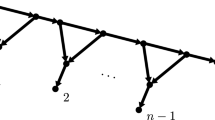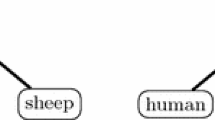Abstract
In this work we propose the partial Wiener index as one possible measure of branching in phylogenetic evolutionary trees. We establish the connection between the generalized Robinson–Foulds (RF) metric for measuring the similarity of phylogenetic trees and partial Wiener indices by expressing the number of conflicting pairs of edges in the generalized RF metric in terms of partial Wiener indices. To do so we compute the minimum and maximum value of the partial Wiener index \(W\left(T,r, n\right)\), where \(T\) is a binary rooted tree with root \(r\) and \(n\) leaves. Moreover, under the Yule probabilistic model, we show how to compute the expected value of \(W\left(T,r, n\right)\). As a direct consequence, we give exact formulas for the upper bound and the expected number of conflicting pairs. By doing so we provide a better theoretical understanding of the computational complexity of the generalized RF metric.



Similar content being viewed by others
Notes
In the analysis of algorithms asymptotic notations, that ignores the constant factors and low order terms in expressions, are commonly used to evaluate the performance of an algorithm. We will use Θ(·) notation in order to simplify expressions, i.e. W(n) = Θ(nlog n) states that W(n) is asymptotically (i.e. for large n) 'behaving' as the nlogn function. For the precise definition of Θ notation we refer an interested reader to (Cormen et al. 2009. chapter 3).
References
Böcker S, Canzar S, Klau GW (2013) The generalized Robinson-Foulds metric. Springer, Berlin, pp 156–169
Bryant D, Steel M (2009) Computing the distribution of a tree metric. IEEE/ACM Trans Comput Biol Bioinf 6(3):420–426
Cormen TH, Leiserson CE, Rivest RL, Stein C (2009) Introduction to algorithms, 3rd edn. The MIT Press, Cambridge
Coronado TM, Mir A, Rossello F, Rotger L (2020) On Sackin’s original proposal: the variance of the leaves’ depths as a phylogenetic balance index. BMC Bioinform 21(1)
Fischer M (2021) Extremal values of the Sackin Tree Balance Index. Ann Comb 25:515–541
Goh C-S, Bogan AA, Joachimiak M, Walther D, Cohen FE (2000) Coevolution of proteins with their interaction partners. J Mol Biol 299(2):283–293
Gutman I, Trinajstić N (1972) Graph theory and molecular orbitals. III. Total π-electron energy of alternant hydrocarbons. Chem Phys Lett 17:535–538
Hainke K, Rahnenführer J, Fried R (2012) Cumulative disease progression models for cross-sectional data: a review and comparison. Biom J 54(5):617–640
Hosoya H (1971) Topological index. Bull Chem Soc Jpn 44:2332–2339
Huang WC, Yang BY, Yeh YN (1997) From ternary strings to Wiener indices of benzenoid chains. Discret Appl Math 73:113–131
Kirkpatrick M, Slatkin M (1993) Searching for evolutionary patterns in the shape of a phylogenetic tree. Evolution 47(4):1171–1181
Knuth DE (1997) The art of computer programming, 3rd edn. Addison-Wesley, Reading
Lin Yu, Rajan V, Moret BME (2012) A Metric for phylogenetic trees based on matching. IEEE/ACM Trans Comput Biol Bioinf 9(4):1014–1022
McKenzie S (2001) Properties of phylogenetic trees generated by Yule-type specification models. Math Biosci 170:91–112
Randic M (1975) Characterization of molecular branching. J Am Chem Soc 97/23:6609–6615
Robinson DF, Foulds LR (1981) Comparison of phylogenetic trees. Math Biosci 53(1–2):131–147
Sackin MJ (1972) Good and bad. Phenograms Syst Biol 21(2):225–226
Shao K-T, Sokal RR (1990) Tree balance. Syst Zool 39(3):266–276
Steel M, McKenzie A (2001) Properties of phylogenetic trees generated by Yule-type speciation models. Math Biosci 170(1):91–112
Tai K (1979) The Tree-to-tree correction problem. J ACM 26(3):422–433
Wiener H (1947) Structural determination of paraffin boiling points. J Am Chem Soc 69(1):17–20
Yang BY, Yeh YN (1995) Zigging and zagging in penta chains. Adv Appl Math 16:72–94
Yule GU (1925) A mathematical theory of evolution, based on the conclusions of Dr J. C. Willis. Philos Trans R Soc Lond B 213:21–87
Acknowledgements
Authors gratefully acknowledge significant contribution of the anonymous referee whose advices immensely improved this paper.
Author information
Authors and Affiliations
Corresponding author
Additional information
Publisher’s Note
Springer Nature remains neutral with regard to jurisdictional claims in published maps and institutional affiliations.
Rights and permissions
Springer Nature or its licensor (e.g. a society or other partner) holds exclusive rights to this article under a publishing agreement with the author(s) or other rightsholder(s); author self-archiving of the accepted manuscript version of this article is solely governed by the terms of such publishing agreement and applicable law.
About this article
Cite this article
Vukičević, D., Matijević, D. The Connection of the Generalized Robinson–Foulds Metric with Partial Wiener Indices. Acta Biotheor 71, 5 (2023). https://doi.org/10.1007/s10441-023-09457-7
Received:
Accepted:
Published:
DOI: https://doi.org/10.1007/s10441-023-09457-7




